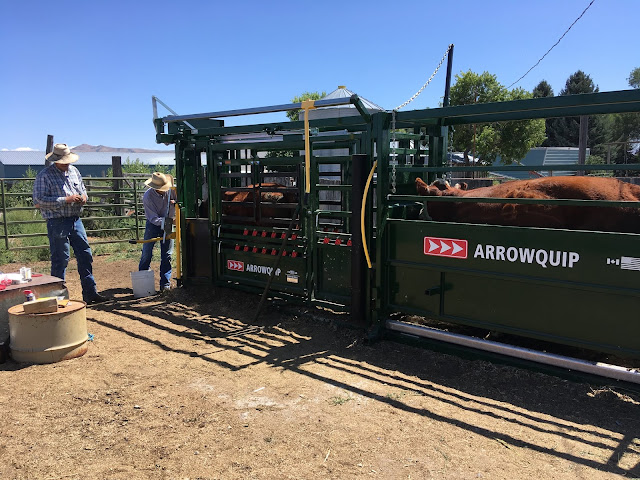Seth and Leah were married here at the ranch in June. I had
anticipated the event for so long, and it was such a big undertaking that I
admit to being a bit discombobulated in the aftermath. Just three short days
after the wedding, hardly time to catch our breath, we took a trip to Oregon.
Upon our return, irrigation water was ponding on the site of the ceremony, and
the net wire fence that had been folded back to accommodate the wedding
procession had been spliced and closed. Did it really ever happen at all?
A ranch doesn't easily lend itself to formal festivities.
Me in heels and Mark in a suit – to stay home? We don’t have a showplace for
sure, but our sturdy, native trees are wonderful, and a pasture of grass with the
Blackfoot River hills in the distance was just right. We were pleased that
California-raised Leah chose the ranch for the event. Getting to know her close-knit, fun-loving family, and giving them a taste of Leah’s new life was a total
pleasure.
In anticipation of hosting guests, we took the opportunity
to clean up around the ranch headquarters where Seth and Leah live, as well as our
home where the wedding would be held. Various objects that we’ve walked and
driven by for years suddenly looked out of place and had to go. I moved the dog
houses, planted grass here and there and trimmed trees. A new coat of paint on
the hitching rail and the propane tank, fresh oil on the saddle shed, along
with a generously wet spring helped a lot.
Weather was always the wild card. It has been cold and rainy
this spring, and with wind in the forecast, Seth and Leah made a last minute
decision to move the reception venue to Gary and Anita’s new dog working arena.
Our lumber cousins provided wood chips to cover the dirt floor, which, along
with a sod encircled dance floor and drapes and lights strung thru the rafters,
transformed the space. I fashioned a wreath of rusted barbed wire rolled up from a
long forgotten fence and adorned with greenery. Add formal tables and chairs, a
handmade drink bar, straw bales to soften the sounds, and we had us a party.
Friends and family made it a homemade event in lots of ways.
Many hands went to work to pull the whole thing off. My sister, niece and
cousin created the meal. The Blackfoot FFA Floral club did a great job with the
flowers. More high school students helped with set-up and parking to fund FFA
travel in the coming year. And the most important part, the ceremony, was
beautifully written by Leah’s Aunt Rachel. Rachel, who is Jewish, shared three Hebrew
words with us, Baruch atah Adonai,
which I learned later essentially means, “Thank you, God.” The words began each
of seven blessings for the couple which were full of rejoicing for the unity of
all, for peaceful and harmonious relationships with one another and the world,
for inspiration, abundance and love. Seth and Leah followed the blessings with their
own handwritten vows which were perfect in every way.
We couples in the audience were moved (as is usual at
weddings) to remember our own vows. For me and Mark, our vows were shared 29
years ago and don’t exactly roll off the tongue these days. We were reminded to
practice patience and compassion, kindness and forgiveness. To communicate
always, and then communicate some more. To provide a safe place for our spouse.
To focus on the important things and to let go of the rest.
Mark and I wish we could do the kids' wedding all over again. If we could, we’d take
the time to thank each person who helped raise our son. I would slow down and let
the experience soak in a bit. Images and stories keep coming to mind. The fragrance of freshly laid wood chips filling the arena and Anna asking, "Does anyone feel like they're at the 4-H fair?" My carefully tended Olive below the house and how naturally it sheltered guests at tables covered in white linen. A last minute bridal shower the day before the wedding to accommodate traveling guests, a brilliant idea by young people who take on more than we adults ever would. And then, the sweet, supremely happy faces of
Seth and Leah as they cemented a love they’ve shared for over 5 years now.
In the end, it was one more exceptional experience we’ve had
in our role as parents. This ride of a lifetime. Holding tight, opening our arms a bit wider, wrapping up Leah for good.
photo by Anita Pratt
photos by Kendra Elise
 |
| Alpha Gamma Roe fraternity serenade |
photo by Anna Pratt
 |
heifers in on the planning
|











































